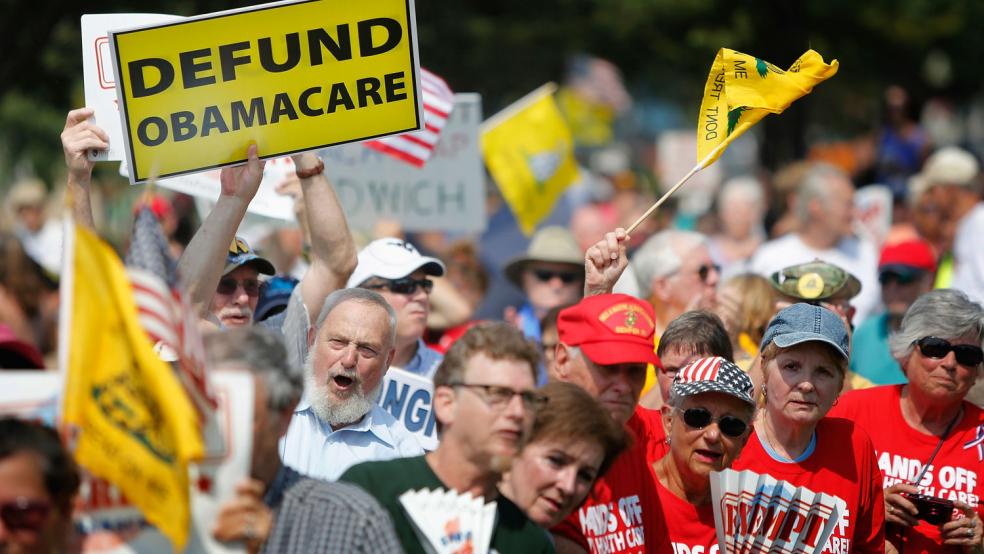With the rollout of the Affordable Care Act individual exchanges less than a week away, the Department of Health and Human Services finally got around to announcing what consumers will  have to pay. Their press release put a positive spin on the data, heralding the “significant choice” that consumers will find in these exchanges – and at “lower than expected premiums.” This, however, is nothing but what Forbes analyst Avik Roy calls “happy talk”
have to pay. Their press release put a positive spin on the data, heralding the “significant choice” that consumers will find in these exchanges – and at “lower than expected premiums.” This, however, is nothing but what Forbes analyst Avik Roy calls “happy talk”
Note well that the HHS release doesn’t claim to have lowered premiums. Barack Obama promised during his 2008 presidential campaign and his push for the ACA that his reforms would lower premiums while “bending the cost curve downward” across the industry – by as much as $2500 a year per family.
The premiums don’t actually go down at all in the approved price lists from HHS, but only have come in under “expectations” from the CBO projections – “16 percent below projections based off of Congressional Budget Office estimates.” More than 95 percent of people live in states where “their average premium is lower than projections,” HHS continues.
However, that doesn’t mean that consumers will pay less, or even that the comparison against projections is honest, let alone comparison to the status quo ante. At Forbes, Roy points out that HHS isn’t just comparing premium costs to projections, but that the projected costs that HHS used came from the CBO’s estimate of premiums for 2016, not 2014.
RELATED: 5 OBAMACARE PROBLEMS THAT SHOULD HAVE BEEN FIXED
What actually does happen to premium costs next week? Bloomberg reported after the release that the average individual policy will cost $2,988 a year through its exchanges. That is 37 percent higher than the average individual health-insurance plan in 2011 ($2,196), the first year in which coverage mandates began to take effect under Obamacare. That’s hardly a downward bend in the cost curve, no matter what kind of apples-to-oranges comparison HHS uses to distract from that steep price hike.
The news gets worse for younger age brackets. Avik Roy worked with the Manhattan Institute to compare prices before and after Obamacare based on HHS data in states where that data has been reported. For 27-year-olds, who must come off of their parents’ plans, the impact is hardly cheery. Thanks to the ACA’s requirement for comprehensive coverage, men in this bracket will pay 97 percent higher rates overall. Rates only go down in two states, Colorado and Vermont. Young women buying individual plans through the exchanges will pay 55 percent higher premiums for coverage than pre-mandate prices.
It gets worse for the next age band. The average 40-year-old man will face a price hike of 99 percent for the cheapest plan available in the exchanges, and as high as 305 percent -- triple the previous average – in North Carolina. The average declined in only one state, Colorado. For women of the same age, premiums jump an average of 62 percent, with a high of 237 percent increase in Nebraska and declines in only three states.
If a retailer tried that with its advertising, the Federal Trade Commission would charge the chain with bait-and-switch fraud.
Younger consumers have a particularly good case to make on this point. Few other demographics had as much enthusiasm for Barack Obama in 2008, and for the health-care reform package Obama promised. The reforms, however, force younger and healthier people into health insurance that hardly fits their needs. The average younger consumer needs to see a doctor only once or twice a year and rarely needs hospitalization, perhaps costing at worst around $500 in an average year for a wellness check with labs and an urgent-care visit. The $3,000 a year that they will now pay on average will far exceed their actual needs, which would have been met with an inexpensive hospitalization plan and health-savings accounts.
Where will the rest of the money collected from young people go? As the Wall Street Journal reminds us yet again, forcing millions of younger workers to pay exorbitant amounts that they don’t use into the risk pool ends up subsidizing the premiums of those who make more demands on the pool – older (and usually wealthier) Americans. That makes for a curious shift of wealth from those with less to those with more, but it also helps curry political favor with older Americans who usually tend to vote more reliably, too.
MORE: THE COST EXPLOSION OF OBAMACARE BEGINS TO HIT HOME
Advocates of Obamacare argue that the price of premium hikes don’t really matter because individuals buying plans in the exchanges will be eligible for subsidies. However, that’s only true for some of those consumers, and that ignores three very salient points.
First, rising premiums demonstrate that the ACA hasn’t actually reformed anything, and second, the subsidies don’t come out of thin air. As premiums skyrocket, more money will be needed from taxpayers to fund those subsidies – taxpayers who are now having to spend a lot more on their own health insurance. Last, as premiums skyrocket, employers will increasingly opt to pay fines and push their employees into ACA exchanges, which will create the need to fund even more subsidies.
Roy also discovers through his joint analysis with the Manhattan Institute that even most of those receiving subsidies will pay more for health insurance overall, and that becomes more evident as the consumer ages.
“In the 13 states plus D.C.,” Roy writes, “a 27-year-old would have to make 59 percent of the median income of his peers, or less, to come out ahead with regard to Obamacare’s subsidies. A 40-year-old would have to make less than 57 percent of the median income for his peers.” Older people do much better. “The average 64-year-old who makes less than 111 percent of the median income for 64-year-olds will spend less on premiums than he did before. … [The] overall results make clear that most people will not receive enough in subsidies to counteract the degree to which Obamacare drives premiums upward.”
That’s the kind of reality that HHS’ happy talk is designed to disguise. It’s not just bait-and-switch; it’s downright Orwellian.






